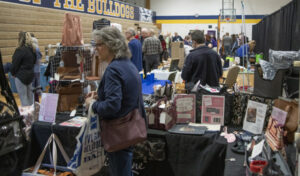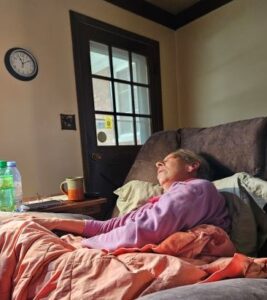
By Crystal Hayduk
As the youngest sibling in a family of three Science Olympiad competitors, sophomore Bennett Proegler ended his fifth year disappointed that the Chelsea High School (CHS) team did not qualify for the state competition following their regional meet at Hillsdale College in late March.
However, their coach, Christine Forsch, and his teammates are developing a plan in hopes of getting there next year.
“Science Olympiad is an extracurricular educational program with a mission to inspire the next generation of scientists, health professionals and engineers” (http://miscioly.org/about-us/).
Students compete in 23 subjects under classifications that include life, personal and social science; physical science and chemistry; inquiry and nature of science; earth and space science; and technology and engineering.
“Our team does really well for the school’s size,” said Forsch, who has coached for 16 years. “We compete against the larger schools who bring two teams each. Since only one team scores, they can pick their top students to score.
“This was our first year where we had a few events that weren’t even covered. We didn’t have enough people, and I didn’t push them. I stress to the students that this is their team,” she said.
CHS placed fifth out of seven schools at the regional competition. Students took first place in Forensics (Carolyn Pierce and Kylie Saxton) and Rocks and Minerals (Madilynn O’Hara and Emma Stanavich). The team placed second in Chemistry Lab (Bennett Proegler and Kylie Saxton).

Proegler believes that the team is very good for only meeting twice a week, but he thinks it could be better. “The most challenging part of high school Science Olympiad is that there are so many extracurriculars that people do, which means the students are spread very thin,” he said.
Freshman Mallery Bee, whose involvement in Science Olympiad made her more appreciative of science and teamwork, had to learn how to juggle her obligations. “I learned a lot about commitment and how much of a difference practice makes. I’m [also] a member of the choir, I run track and cross country, and am the freshman treasurer for student council.”
In her sixth year with Science Olympiad, junior Kylie Saxton values the team and the coach. “Most people who participate work hard and have the same goal of studying science in the future, making us all nerds who get along very well,” she said. “I’ve learned a lot through great leadership as well. Mrs. Forsch has made Science Olympiad a club I truly enjoy attending every week…. She’s a caring and wonderful mentor.”
Carolyn Pierce, a freshman who joined the middle school team in sixth grade, continues in the club because “…I’m learning things that will help me pursue a career in science.” She said that at the high school level, the group meets together but students primarily work with partners or individually. “The middle school had coaches for every subject.”

“Coaching comes at all levels,” said Forsch. “In order to better compete, our team could use more parent coaches. If you have an interest or background in one of our event topics, please donate a few hours and share that knowledge with the students on that team. And, if you are a parent helping your student with their events, you are a coach.”
Quick Facts
Who: Fifteen students comprise a team.
What: Students learn information and build items, depending on the event. Events may vary from year to year. A complete list of 2017 events can be found here.
When: Students meet after school twice a week to work on projects, from late September to late March. The season may extend to late April if they move on to the state competition.
Where: The Science Olympiad team competes at an invitational and a regional event each winter, in locations that may vary. The 2017 invitational was held at Ionia High School; the regional was held at Hillsdale College.
How: With support from the Chelsea School District, Science Olympiad receives funding from the Chelsea Education Foundation.
Why: Team members receive opportunities to learn about a variety of college-level science- and technology-related subjects. They work through practical applications of the scientific method and exercise thought processes. Camaraderie develops between students who are interested in STEM subjects, and they enjoy the excitement of competition.










